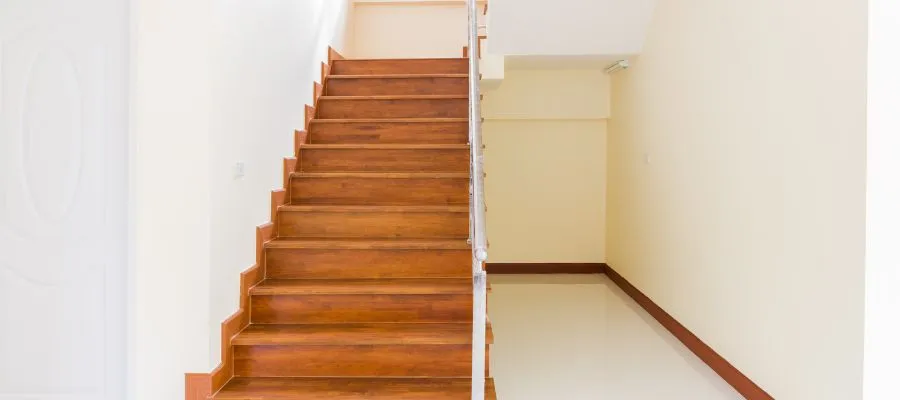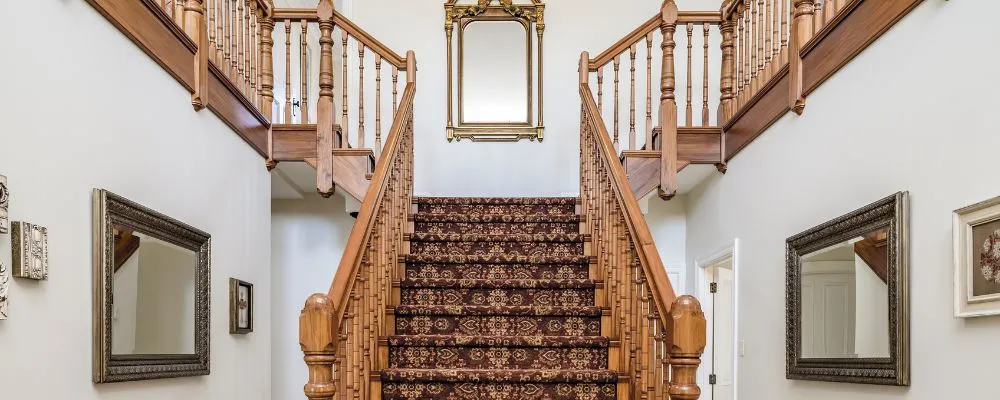Stairs are an important part of building design that is often overlooked, but they are also very important for how the building looks. The design and construction of stairs greatly affect the general look and usability of a building, whether it’s a home or an industrial complex. In this blog, Brick & Bolt looks at the different types of stairs that are widely used in building construction and explains their unique features, benefits, and best uses.
Different Types of Stairs in Building Construction

Stairs are a set of steps or flights that let people move from one level of a building or structure to another. They can have different shapes and sizes depending on the needs of the architecture and the function.
From classic straight stairs to contemporary spiral designs, each type of staircase offers unique characteristics and advantages.
Let’s get into the types of stairs in building construction:
1. Straight Stairs
Straight stairs are the simplest and most common type, featuring a continuous flight of steps without any changes in direction. They are easy to design, construct, and navigate, making them perfect for various settings, including homes, offices, and public buildings.
Advantages of Straight Stairs
- Straight stairs are popular because they are easy to use and space-efficient. They are also easy to put together, which saves time and money during the building process because they are simple.
- Their linear design means they don’t take up much floor room, which makes them useful in a wide range of architectural settings.
- t also makes it easier for people of all ages and abilities to use, since the steps are all the same and there are no landings or turns.
- Straight stairs can be made from a variety of materials and designs, so they can fit a wide range of aesthetic tastes and building needs.
2. L-Shaped Stairs
As the name suggests, a 90-degree turn makes an “L” shape on L-shaped stairs. This design gives you more freedom in planning your space, and it’s often used in apartment buildings where you need to change directions because of limited room or your personal taste in architecture.
Advantages of L-Shaped Stairs
- Firstly, their design allows for efficient use of space, particularly in tight or compact areas, as they can be tucked into corners or against walls.
- This layout also provides a natural transition between floors, promoting smooth traffic flow within a building.
- L-shaped stairs tend to be safer than straight stairs, as they typically incorporate landings or platforms at the turn, offering resting points and reducing the risk of accidents.
- Their aesthetic appeal and versatility make them suitable for various architectural styles, from modern to traditional, enhancing the overall visual appeal of a space while ensuring practicality and functionality.
3. U-Shaped Stairs:
U-shaped stairs involve two flights of steps parallel to each other with a landing in between, making a “U” shape. Larger buildings or homes with plenty of room usually have this design when there is a long vertical distance to be crossed.
Advantages of U-Shaped Stairs
- One big advantage is that they make good use of space because they can often fit neatly into a corner or up against a wall, making the most of the floor space you have.
- The U-shaped stairs usually have steps or platforms at each turn. These give you a place to rest and lower the risk of accidents.
- The symmetrical and aesthetically pleasing layout of U-shaped stairs can improve the look of a room as a whole, going with a variety of architectural styles while still being useful and stylish.
4. Spiral Stairs
Spiral stairs are also known as circular stairs or helical stairs. Spiral stairs feature a central column around which the steps wind in a helical pattern. These stairs are prized for their compactness and aesthetic appeal, making them popular choices for both indoor and outdoor uses, such as towers, lofts, and historical buildings.
Advantages of Spiral Stairs
- They are perfect for places that are tight on space because they are small and take up little room. They make good use of floor space while still letting you get from one level to another.
- This adaptability means that spiral stairs can be used both inside and outside, and they can fit in with a wide range of architectural types and settings.
- Spiral stairs have a unique look that makes any room look more elegant and sophisticated. Their curved shape makes a striking focal point that adds to the general atmosphere and architectural interest.
- Spiral stairs can be changed to fit different design tastes and practical needs, so they are flexible in both form and function.
5. Curved Stairs
The beautiful curves or arcs of curved stairs make a sweeping effect. You can find them in high-end homes, luxury hotels, and big public buildings. They add a touch of class and elegance to any building plan.
Advantages of Curved Stairs
- It provides a striking centre.
- Improves the look of architecture.
- Curved stairs are a stylish and space-saving option that can make a room look better while making the most of its floor space.
6. Floating Stairs
Floating stairs, which are also called cantilevered steps, look like they don’t have any supports, which makes them look clean and simple. These stairs depend on hidden structural supports or brackets attached to the wall, creating a striking visual effect that exudes modernity and sophistication.
Advantages of Floating Stairs
- They are flexible in form because they can be changed to fit different architectural styles and tastes.
- Their simple design makes them easy to clean and maintain, which adds to their clean, clear look.
- Floating stairs also give the impression that they are light and not heavy, which makes them a striking focal point in any room.
7. Split Stairs
Split stairs are also known as bifurcated stairs. Split stairs have a landing in the middle that splits the stairs into two separate flights, each going in a different way. This design makes a striking visual effect and gives any area, inside or out, a touch of architectural sophistication. There are different ways to set up split stairs based on how the building is laid out and how much space is needed.
Advantages of Split Stairs
- Split stairs are also easy to build in a way that works with a variety of architectural styles and tastes.
- They can also give a room a sense of greatness and elegance, especially in entryways or larger rooms.
8. Ladder Stairs
Ladder stairs, which are also called alternating tread stairs or ship ladders, are a unique and space-efficient way to make vertical movement work in buildings. Ladder steps are different from regular stairs because they have alternating treads that let people go up or down with a steeper slope. Ladder steps have clear benefits in some situations, but they might not be right for everything.
Advantages of Ladder Stairs
- Need less floor space because they slope steeply.
- Make it easy to get to higher levels in small areas.
- It can be changed to fit different styles, tastes, and space needs.
9. Crossover Stairs
Crossover stairs, which are also called crossover bridges or pedestrian overpasses, are raised walks that let people safely cross over things likes machines, moving parts, pipes, or other things that might be in the way in a building. These structures make crossing easy and quick because you don’t have to deal with traffic on the ground.
Advantages of Crossover Stairs
- Crossover stairs are safe for people to use because they let them cross over busy places without blocking traffic.
- Everyone can use these stairsmaking it easy to get across town.
- Crossover stairs help traffic move better and reduce congestion by separating people from cars. This makes it faster for both walkers and drivers to get where they need to go.
10. Scissor Stairs
Scissor stairs have a unique design with treads that go back and forth. They are also called switchback stairs or alternating tread steps. Unlike regular stairs, where each step is flat, scissor stairs have steps that change curves, making them look like a pair of scissors opening and closing. Because of their form, scissor stairs can have a steeper slope while still providing a stable footing. This makes them a good choice for buildings with limited floor space. They are often used in factories, lofts, and other places where traditional stairs might not work because of limited room.
Advantages of Scissor Stairs
- Scissor stairs are small, they make good use of room and are ideal for places with limited floor space.
- Their form can also be changed to fit any building, and it gives it a modern look that makes it look better overall.
When it comes to building, the choice of stairs is more than just a matter of function; it’s also a chance to improve the structure’s look and how it flows. Architects, designers, and homeowners can make choices that improve both form and function by learning about the differences between stair types and how they can be used.
We at Brick & Bolt know how important stairs are in the planning and construction of buildings. Our team of experts is dedicated to making your construction dreams come true, whether you want a traditional straight staircase or a modern floating design. Get in touch with us right away to start your stairway to greatness journey.

